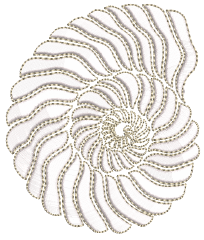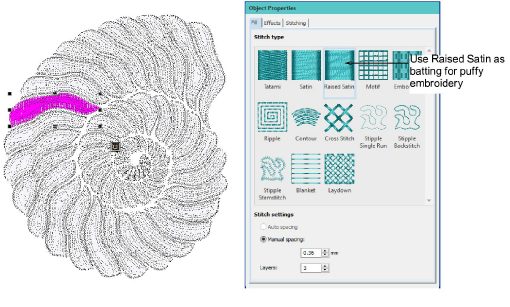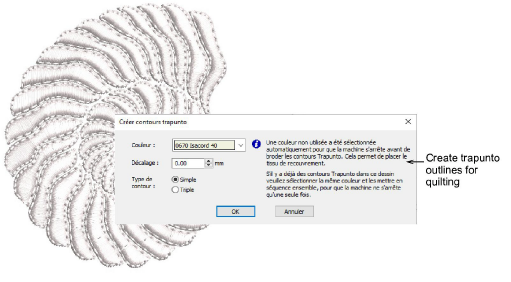Trapunto embroidery
 Quilted embroidery creates dimension by stuffing or filling areas to produce a raised surface. It employs a technique known as ‘trapunto’, also referred to as ‘stuffed embroidery’. There are a number of techniques for creating trapunto designs.
Quilted embroidery creates dimension by stuffing or filling areas to produce a raised surface. It employs a technique known as ‘trapunto’, also referred to as ‘stuffed embroidery’. There are a number of techniques for creating trapunto designs.
Trapunto techniques
Traditional hand trapunto involves sewing two layers of fabric together with a motif outline. The underside is then slit and stuffed with yarn or cotton. Another technique – sometimes called machine trapunto or cut-away trapunto – is to mark the design pattern on top of the quilt fabric with a water soluble marker. A layer of batting is then pinned to the underside of the fabric and two layers are stitched together. The batting is trimmed close to the stitching to create the embossed design. The quilt is then constructed by sewing the quilt top to the quilt back with another layer of batting in between.
Raised satin
Yet another technique is to use layers of thread instead of stuffing or batting to create dimension. The embroidery design consisting of multiple layers of satin stitching is first stitched onto Aqua Mesh water-soluble stabilizer. Then a top and bottom layer of fabric are added before the final outline is stitched around the design. Recommended settings for best loft are 0.36mm manual for satin spacing with 3 layers.
Quilting design work relies on two main tools:
-
Raised Satin: This allows you to create ‘puffy embroidery’. Outlines can be used for lettering and special calligraphy effects.
-
Trapunto Outlines: This allows you to turn puffy embroidery designs into trapunto quilting designs.
The puffy embroidery component allows you to create raised embroidery consisting of multiple layers of satin stitches. This is as an alternative to stuffing with yarn or batting. The trapunto component allows you to stitch layers of fabric over the raised satin. The Trapunto Outlines feature is used exclusively with Raised Satin to create a ‘quilted’ look. When activated, this feature always defaults to the next unused color so as to force the machine to stop before trapunto outlines are stitched. This allows you to place the covering fabric.
Study the quilting design included in the designs folder. Try stitching it out to practice the techniques involved. Check your machine documentation.










